The general life cycle of turtles are shared by all sea turtle species, with some small differences. Common for all sea turtles is that their life cycle is quite complex; they depend on the ocean to feed and grow but need sandy beaches to reproduce. Adults of all species (except the flatback) must make long migrations to reproduce as the distance between feeding and breeding areas can be hundreds to tens of thousands of kilometers. For female sea turtles this process is so exhausting that they usually only nest every 2-3 years.
Females of all species return to the beach where they were born to nest, a phenomenon named “natal homing”. Since sea turtles grow very slowly, they can take up to 50 years to reach sexual maturity–which is quite late in life! Sadly, they also have a very low natural survival rate: it is estimated that only one in 1,000 sea turtle hatchlings survive to adulthood.
Sea turtles mating
To mate, the male sea turtle climbs onto the female turtle’s back and holds on to her carapace with the long, sharp claws of his front flippers. The way he hooks on to the edge of the female’s shell often results in a scratched shell and bleeding wounds in the soft parts of her body. Copulation can take place on the surface or under water.
Females can mate with more than one male in a season. As a result, each nest can have embryos of different fathers. Female sea turtles can also store sperm so that consecutive nests can have embryos of the same father.
Sea turtle nesting
Female sea turtles usually nest at night to prevent predators and heatstroke. Some species, however, such as the olive ridley turtle and the hawksbill turtle can be found regularly nesting at day time! The nesting process can take from 45 min to 5h. A female sea turtle can nest several times during each nesting season and will make anywhere from 2 to 8 nests to maximize the number of eggs laid.
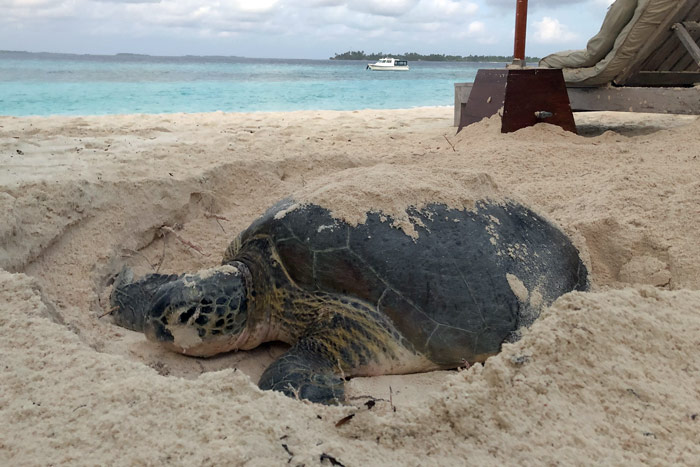
It is a huge effort for a female sea turtle to drag her body up the beach using only her flippers. During this ordeal, she can be easily disturbed and will sometimes abandon the nesting attempt, known as a false crawl.
Once she is above the high tide line, she first starts clearing an area of debris. She then creates a body pit to lie in comfortably before starting to dig the nest. Using her hind flippers, she digs a deep nest chamber, stopping only when her hind flippers cannot reach to pull any more sand from the hole.
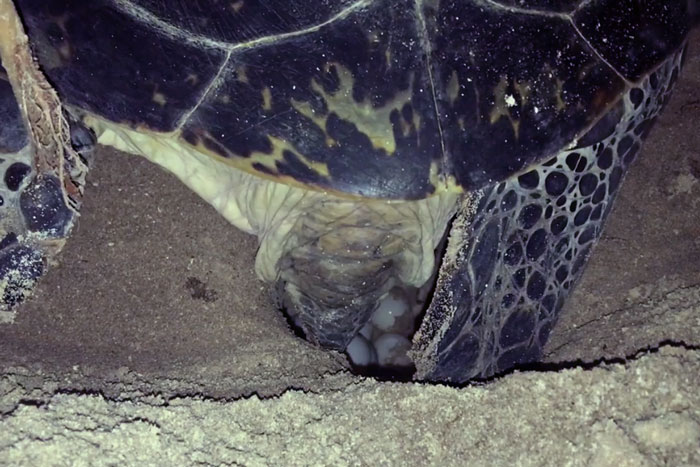
During nesting, the female turtle enters a trance like state. She lays her eggs in batches of two-to-three at a time. The average nest contains between 80 and 200 eggs depending on the species, with smaller species laying more eggs.
Each egg is about the size of a ping pong ball. It has a yolk and is soft shelled to prevent it from breaking when dropped into the nest. The soft shell also allows the eggs to remain moist and exchange oxygen.
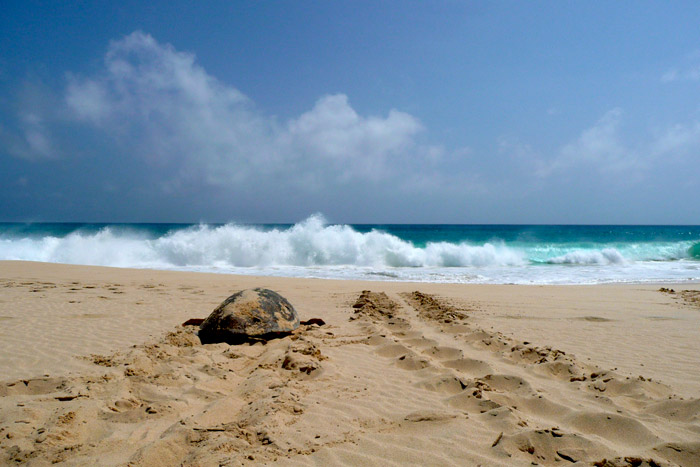
After all the eggs are laid, the female sea turtle fills in the hole with her hind flippers and packs down the sand. Finally, she will camouflage the nest by throwing sand backward with her front flippers. Once she is done, she will return to the water for a well deserved rest of 10-15 days!
After nesting season is over, females return to their feeding areas– generally nearshore (neritic) areas–to replenish their energy stores for the next reproductive season. This period typically takes more than a year, and in many cases, several years.
Sea turtle incubation and sex determination
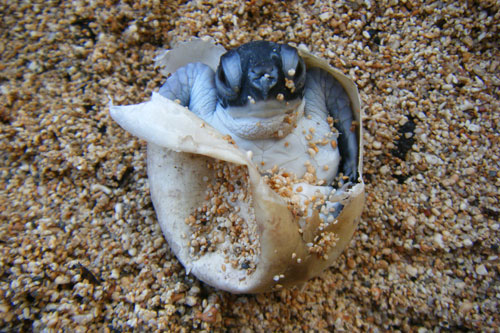
Sea turtle eggs incubates in around 60 days, but since the temperature of the sand governs the speed at which the embryos develop, the hatching period can vary. Essentially, the hotter the sand surrounding the nest, the faster the embryos will develop.
In addition to affecting the incubation period, the temperature of the nest also determines the sex of the sea turtle hathlings. In sea turtle nests, warmer eggs produce females while cooler eggs tend to be males. This type of gender determination means that nests, depending on their temperature, can hatch all males or all females. Typically, however, eggs in the deeper, cooler area of the nest hatch as males and the warmer top of the nest is female-dominated.
Hatchling emergence
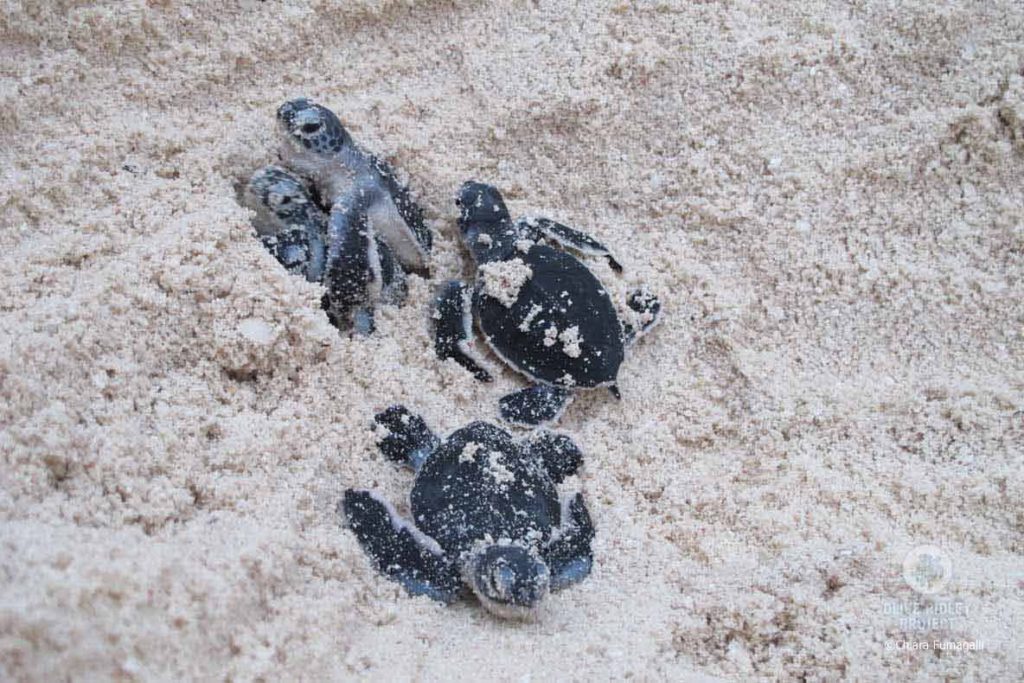
Hatchlings use a temporary tooth-like outgrowth called caruncle, which is specially adapted for this purpose and falls off soon after hatching, to break the egg shell. Once the first hatchling emerges from its egg, it is not long before the entire nest follows. Climbing up the nest chamber takes huge collaborative effort, with hatchlings situated at the top of the nest being pushed out by the ones beneath them. This process can take between 3-5 days.
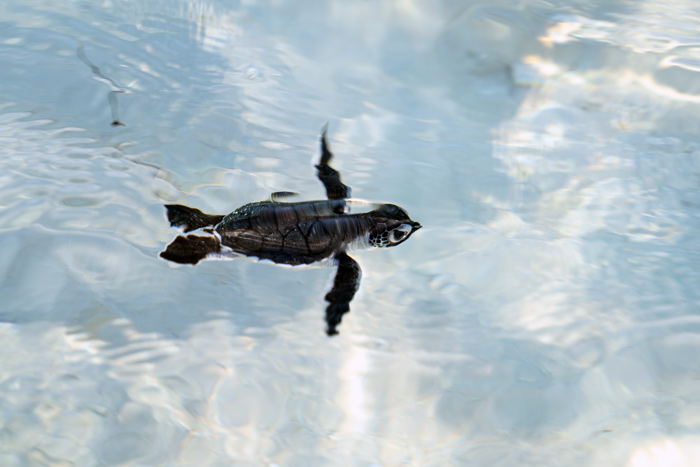
Hatchlings usually emerge at nightfall in order to avoid both daytime predators and heat exhaustion. Once on the beach, hatchlings scramble to the ocean as quickly as possible, guided by the moon light reflecting on the horizon.
After reaching the water, hatchlings enter into a multi-day “swimming frenzy,” during which they swim almost continuously, fueled only by leftover egg yolk, to reach deeper water away from shore.
The lost years of sea turtles
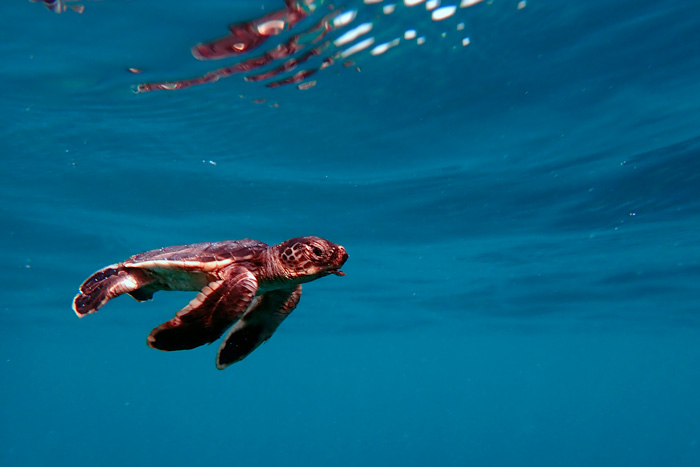
There is still much we don’t know about the life cycle of turtles. Scientists are still unsure exactly where turtle hatchlings spend the first few months or years of their life. Hatchlings probably enter an oceanic phase after leaving their nesting beach. They find shelter in mats of algae, floating passively in major current systems (or gyres), and feed on the surface on pelagic vegetation and animals.
Life of juvenile sea turtles
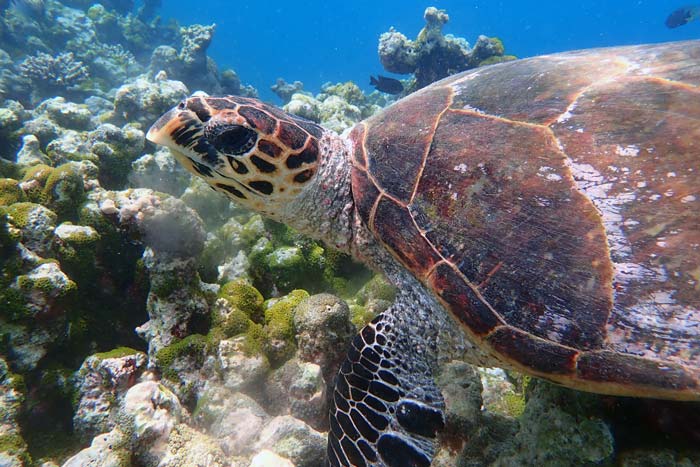
After one to ten years in the oceanic zone, some species of turtles retreat to coastal areas where they forage and grow until maturity. This process can take anything from a few years to a few decades.
While these foraging grounds tend to offer a greater abundance and variety of food than the open ocean, they also tend to host more predators. Thus, young turtles wait to enter these areas until they have attained a larger body size, which helps them avoid being eaten.
Juvenile sea turtle diet
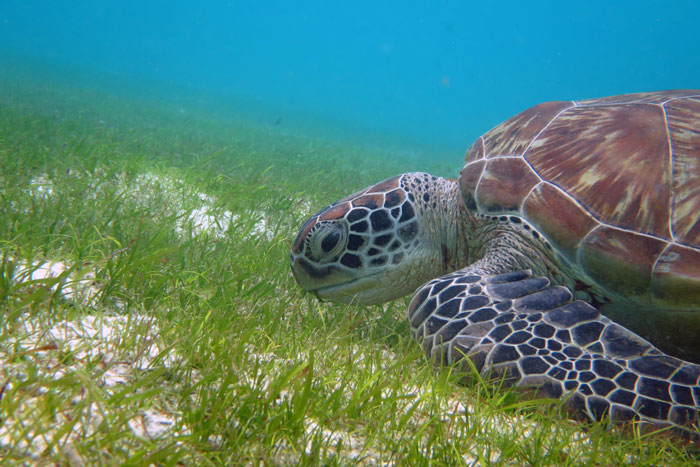
Green, hawksbill and loggerhead turtles probably move from oceanic to coastal habitats at about 10-15 years of age. Their diet then becomes specialized according to the available food sources in their chosen habitat, such as seagrass beds, coral and rocky reefs, mangroves and estuaries. After this, they will only return to the deep ocean for migration and reproduction.
Leatherbacks and olive ridleys, on the other hand, will spend both developmental and adult stages in oceanic zone
Growth and maturity
There is no way to determine the exact age of a sea turtle from its physical appearance other than to establish if it is a hatchling, juvenile or adult, depending on its size. It’s also tricky to tell visually if an animal is mature or not. This is especially true for females: they can be big enough but not actually be sexually mature. What we do know is that sea turtles live a long time, possibly up to 50 years or more. Most sea turtles take decades to mature—between 20 and 30 years—and remain actively reproductive for another 10 years.
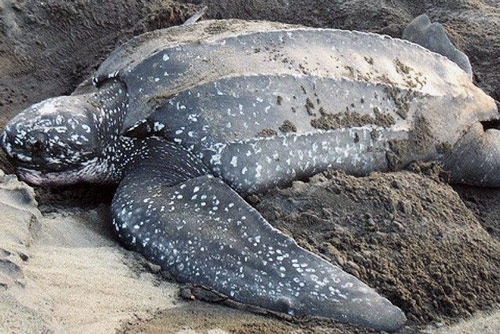
Leatherbacks
Leatherbacks, the largest of all sea turtles, measure on average 1.5 – 2m (4-6 ft) long and weigh 300 – 500 kg (660 to 1,100 lbs). The largest leatherback ever recorded was 2,56 m (8.4 ft) long and weighed 916 kg (2,019 lbs)!
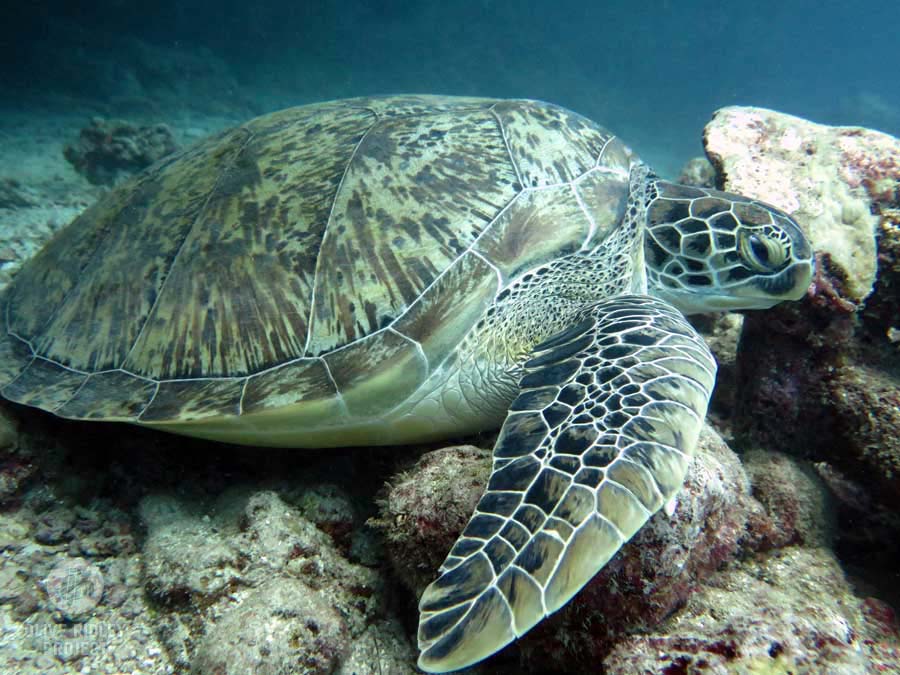
Green turtles
The greens are generally larger than hawksbills. Nesting green females have been reported with a curved carapace length of 75-134 cm (2.5-4 ft), weighing (after egg deposition) 45-250 kg (92.5-551 lbs).
Maturity age range: 25 to 50 years
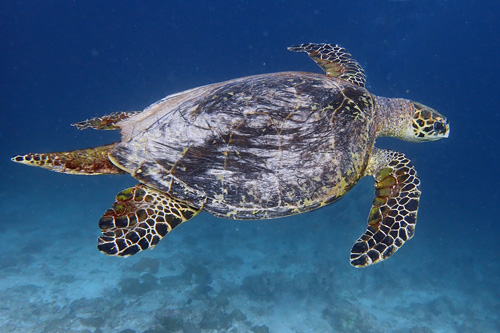
Hawksbills
Nesting female hawksbills measure between 53.3 and 95.5 cm (1.7-3 ft) in carapace length, weighing between 27.2 and 86.2 kg (60-190 lbs).
Maturity age range: 20 to 25 years
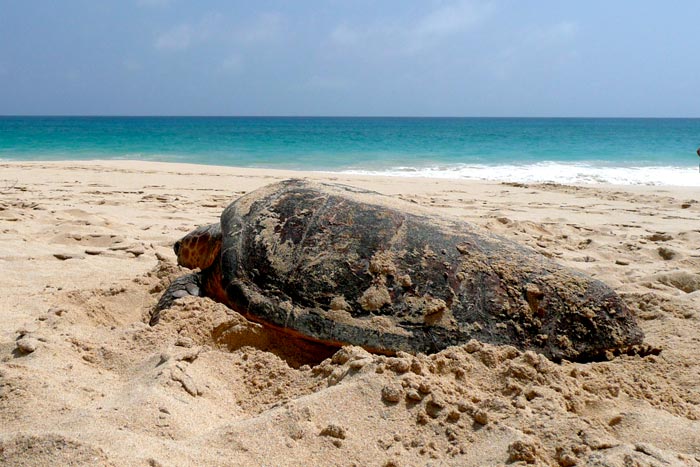
Loggerheads
Adult loggerhead turtles measure between 65 and 115 cm in curved carapace length and typically weigh between 40 and 180 kg. The largest recorded loggerhead weighed 545 kg and measured 213 cm in presumed total body length. Males fall into the same size range (79.0-104.0 cm curved carapace length).
Maturity age range: 25 to 35 years
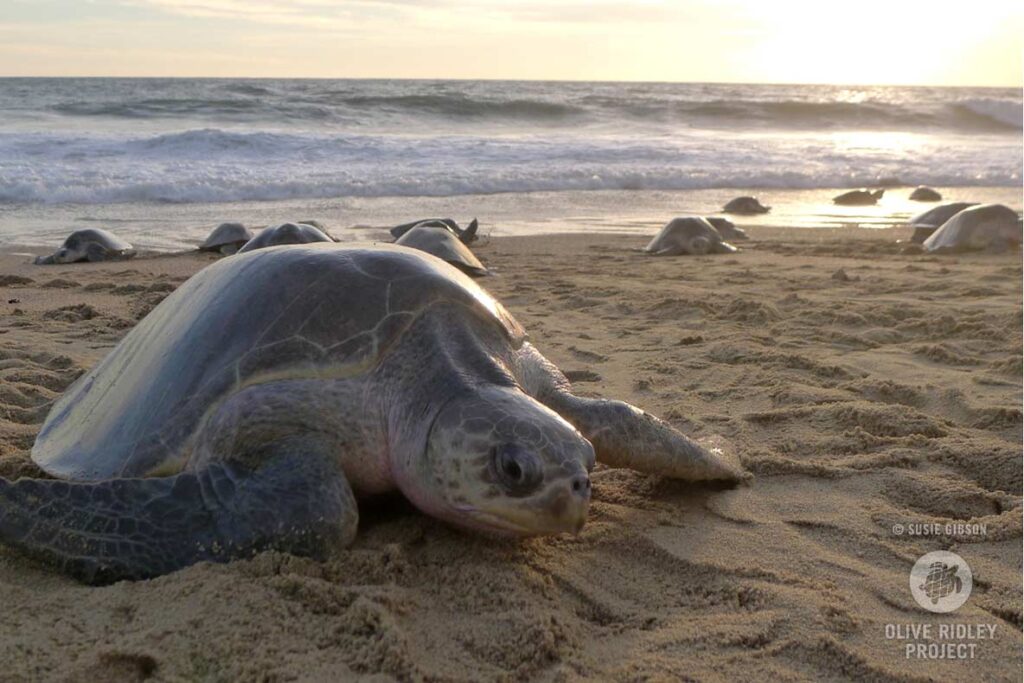
Olive and Kemp’s ridleys
The olive and Kemp’s ridley turtles are the smallest species of sea turtles. They grow only to about 70 cm (just over 2 feet) in shell length and weigh up to 45 kg (100 lbs).
Maturity age range: 10 to 15 years
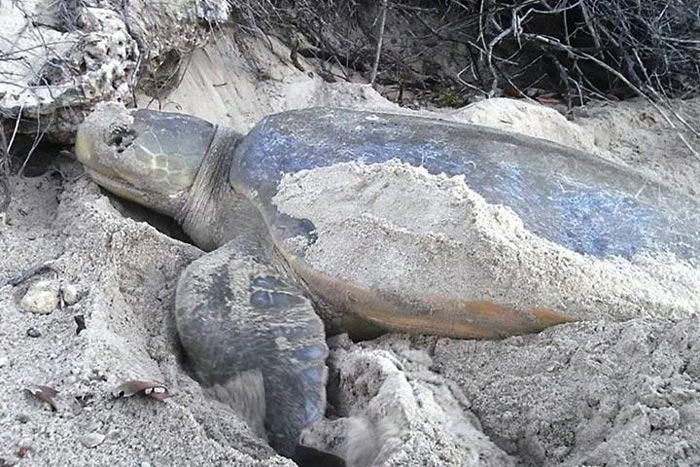
Flatbacks
Unfortunately, there is little data for flatbacks. One study found that nesting females have a mean curved carapace length 86.3 cm and mean weight of 67.4 kg. However, another study found flatbacks to be between 87.5-96.5 cm.
Maturity age range: unknown
Full circle
The life cycle of turtles repeats. Adult males and females of all species (except the flatback) make the long migrations from their feeding grounds to their breeding grounds to reproduce.


